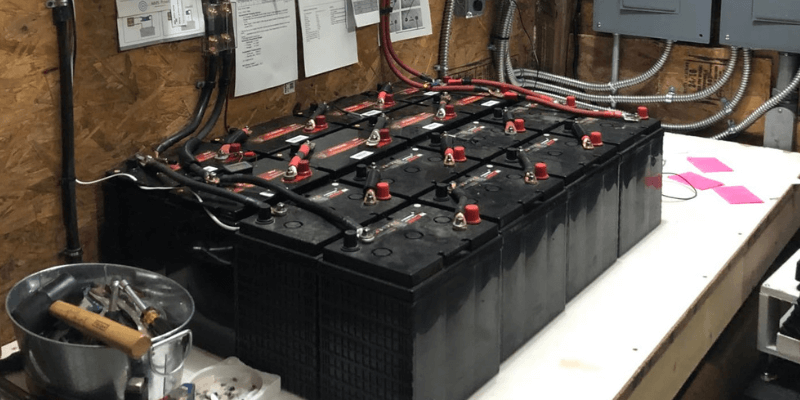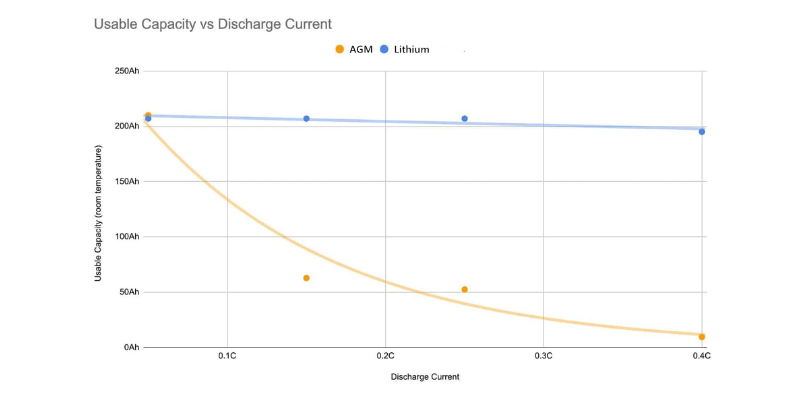에너지 시스템 용 배터리를 선택하는 것은 크기, 앰프 시간, 전압 및와 같은 사양으로 인해 압도적 일 수 있습니다. 사이클 수명및 효율성. 주요 사양 중 하나는 예비 용량이며, 이는 지속적인 부하에서 수명 및 성능에 영향을 미칩니다. 다음 배터리에 투자하기 전에 예비 용량에 대해 알아야 할 핵심 사항은 다음과 같습니다.
배터리 예비 용량은 무엇입니까?
배터리 예비 용량 (RC)은 시간을 몇 분만에, 12V 배터리를 예비 시간에 측정 한 10.5V로 떨어 뜨리기 전에 실행할 수 있습니다. 예를 들어, 150 RC가있는 배터리는 150 분 동안 25A를 공급할 수 있습니다.
같지 않은 AMP-Hours (AH)1 시간 안에 생성 된 전류를 측정하는 RC는 전적으로 시간 측정입니다. 관련이 있기 때문에 다른 하나를 계산할 수 있지만 크게 다릅니다. RC는 AMP 시간에 비해 배터리가 지속적인 하중에서 얼마나 오래 지속되는지에 대한보다 정확한 평가를 제공합니다.

예비 용량을 AMP 시간으로 변환하는 방법?
예비 용량을 AMP 시간으로 변환하려면 RC를 60으로 나누고 25로 곱하십시오. AMP 시간을 예비 용량으로 변환하려면 AH를 25로 나누고 60을 곱하십시오.
이것은 간단한 변환이지만 측정 및 변환이 전압을 설명하지 않기 때문에 동일한 에너지를 나타내지 않습니다.
배터리 예비 용량 대 콜드 크랭크 앰프
콜드 크랭크 앰프 (CCA) RC (Reserve Appear) 측정과 혼동됩니다.
몇 분 안에 RC와는 다른 CCA는 AMP로 측정되며 배터리가 0 ° F에서 30 초 동안 전달할 수있는 앰프 수를 나타냅니다.
CCA는 심해 사이클 배터리와 달리 짧은 에너지 버스트와 즉각적인 재충전을 위해 설계된 시동 배터리에 특별히 적용됩니다. 예비 용량 등급은 심해 배터리가 부하에서 얼마나 오래 수행 할 수 있는지 결정하는 데 도움이됩니다.

배터리 예비 용량이 중요한 이유는 무엇입니까?
배터리 예비 용량은 배터리가 일관된 하중에서 작동 할 수있는 길이를 나타내므로 더 긴 방전에 중요합니다.
예비 용량을 이해하면 사용 시간과 사용 가능한 전력을 측정하는 데 도움이됩니다. 150 ~ 240 분의 차이는 배터리 활용과 필요한 수량에 큰 영향을 미칩니다. 예를 들어, 하루 종일 낚시를하는 경우 에너지가 부족하지 않고 집으로 돌아가려면 배터리의 전력과 지속 시간을 아는 것이 필수적입니다.
예비 용량은 또한 발전에 영향을 미칩니다. 전압이 12V에서 10.5V로 떨어짐에 따라 전력 출력도 감소합니다. 에너지는 전력 시간 사용 기간과 같기 때문에 전력 감소는 총 에너지를 감소시킵니다.
배터리 요구는 긴 RV 트립과 가끔 골프 카트 사용과 같은 사용에 따라 다르므로 필요한 예비 용량에 영향을 미칩니다.

배터리 예비 용량은 어떻게 계산됩니까?
배터리 예비 용량은 몇 분 안에 시간을 측정합니다. 12V 배터리의 RC를 계산하려면 다음 단계를 따르십시오.
- 배터리를 100%로 충전하십시오.
- 시계를 시작하고 80 ° F에서 25A를 그립니다.
- 배터리 전압이 10.5 볼트 아래로 떨어지면 시계를 멈추십시오.
- 이 부하에서 지속되는 총 시간은 RC 등급입니다.
리튬마다 예비 용량이 어떻게 다른가? & 산전 배터리를 납?
일반적으로 AMP 시간 또는 와트 시간으로 평가되는 리튬 배터리는 일반적으로 납산 배터리보다 예비 용량이 높습니다.

납산 배터리 경험 Peukert 효과, 배출량이 높아짐에 따라 예비 용량이 감소합니다. 대조적으로, 고품질 리튬 배터리는 대부분의 조건에서 AMP 시간 등급을 유지합니다.
예를 들어, 12V 100AH 납산 배터리의 예비 용량은 약 170-190 분이며 12V 100AH 리튬 배터리는 약 240 분 동안 지속됩니다. 이 높은 예비 용량은 리튬 배터리를 설치한다는 것은 납산 옵션에 비해 공간과 무게를 절약 할 수 있음을 의미합니다.
관련 기사:

